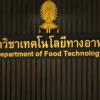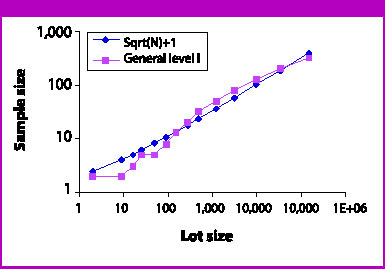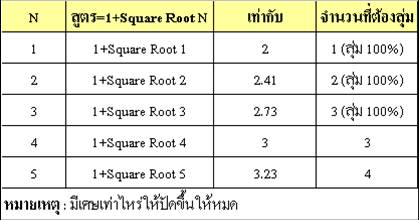ผู้รู้ท่านใดทราบ วิธีสุ่มตัวอย่างวัตถุดิบสำหรับเครื่องสำอาง ช่วยแนะนำด้วยค่ะว่าจะใช้วิธีใดในการสุ่มค่ะ
ท่านที่สมัครสมาชิกเข้ามาใหม่ กรุณารอให้ Admin ได้ทำการ Validate การเป็นสมาชิก ภายใน 24 ชม.ของวันทำการ ซึ่งระหว่างที่รอ Validation ท่านอาจจะยังไม่สามารถดาวน์โหลดข้อมูลต่างๆ ได้ หากไม่ได้รับความสะดวก กรุณาอีเมลแจ้ง isothainetwork@hotmail.com
ช่วยแนะนำวิธีสุ่มตัวอย่างวัตถุดิบสำหรับเครื่องสำอางหน่อยค่ะ
Started by
chalala
, Nov 18 2010 04:59 PM
6 replies to this topic
#1

Posted 18 November 2010 - 04:59 PM
#2

Posted 18 November 2010 - 05:20 PM
ใช้ 1 + Square Root (N) ครับ
"ในโลกนี้ไม่มีคนแปลกหน้าสำหรับเรา มีแต่เพื่อนที่เรายังไม่ได้พบกันเท่านั้น"
E-mail suppadej@gmail.com
#3

Posted 18 November 2010 - 10:17 PM
#4

Posted 18 November 2010 - 10:28 PM
QUOTE(Food Safety @ Nov 18 2010, 10:17 PM) <{POST_SNAPBACK}>
1 มาอย่างไร
ที่ทำงานใช้ Sampling plan นี้สุ่ม RM และเคยถามอาจารย์ ตอนที่ไปอบรม MIL-STD-105E เค้าก็ไม่ทราบที่มาของสูตรนี้ครับ, เคยสอบถาม Auditor ที่มา Audit หลายรายเค้าก็ไม่ทราบครับ บอกเพียงแต่ว่าเป็น Sampling plan นี้เป็นของ Pharmaceutical ครับ (แต่ตอน Audit เค้าก็ไม่ได้ว่าอะไร ที่เรานำสูตรนี้มาประยุกต์ใช้เลยครับ)
แต่พี่ลองอ่านตาม Link นี้ และกราฟ นี้ดูครับ
http://pharmtech.fin...e/detail/631722
โดย Refer. รายละเอียดจาก Web. นี้ มีดังนี้ครับ
"Originating in the 1920s as a sampling scheme for agricultural regulatory inspectors, the square root (Sqrt) of the lot size (N) + 1 was semiformalized in an unpublished report by the Association of Official Agricultural Chemists (now Association of Analytical Chemists) in 1927 (1). Although it was used by nearly every company and by the US Food and Drug Administration, usually for incoming raw materials, most quality personnel questioned the validity of Sqrt(N) + 1 because it could not be found in statistical texts. So the question became, Is it valid and should companies and FDA continue to use and promote it?
Figure 1: Sqrt(N) + 1 versus Z1.4 General Level I.
In February 1995, the US federal government cancelled the Mil Std 105E sampling plan. As a result, ANSI/ASQ Z1.4 became a popular attribute sampling approach (2). Z1.4 is used extensively for contract negotiations between companies and between companies and governments. In the pharmaceutical industry, Z1.4 is used for the attribute sampling of raw materials, in-process materials, and finished products.
According to Z1.4, section 9.1: "A sampling plan indicates the number of units of product from each lot or batch which are to be inspected (sample size or series of sample sizes) and the criteria for determining the acceptability of the lot or batch (acceptance and rejection numbers)." Z1.4 is a statistically valid and statistically based attribute sampling plan with the following characteristics:
The population, lot, or batch size N is considered
The sample size n is specified and related to the lot size by Table I of Z1.4 (2)
An accept number Ac is given (see Table II-A of Reference 2)
A reject number Rc is given (see Table II-A of Reference 2)
The operational characteristic (OC) curve was calculated statistically using known statistical distributions (see Tables X-A to X-S in Z1.4 of Reference 2)
A key point on the OC curve, the acceptance quality limit (AQL), helps characterize the plan.
Consider lot size N = 1000 for an incoming raw material. For less critical materials, it is common to use General Inspection Level I in Z1.4, which leads to a sample size of n = 32. Using the criteria of accept on zero, Ac = 0, and reject on one, Re = 1, Table X-G shows that the AQL for the probability of acceptance Pa = 0.95 is 0.160%. That is, if the average level of nonconformance is equal to or less than 0.160%, then the lots in the series will be accepted 95% of the time.
Now consider the attribute sampling plan based on Sqrt (N) + 1, where Ac = 0 and Re = 1. It is also statistically valid and statistically based in that it has these statistical characteristics:
The population, lot, or batch size N is considered
The sample size n is specified and related to N by n = Sqrt (N) + 1
An accept number is given Ac = 0
A reject number is given Re = 1
The OC curve is calculated statistically using known statistical distributions (3)
The AQL helps characterize the sampling plan.
Consider again the raw material with N = 1000. The sample size is n = Sqrt (1000) + 1 = 32.6 or n = 33. Using Ac = 0, and Re = 1, software calculations show (3) that the AQL for Pa = 0.95 is 0.153%. For all practical purposes, the two plans are the same, given the slight difference in the sample size.
Sample sizes for Sqrt(N) + 1 are very close to the sample sizes in Z1.4 General Level I. For small lot sizes, Sqrt (N) + 1 samples are actually larger than Z1.4 General Level I (see Figure 1).
Both Z1.4 General Level I and Sqrt(N) + 1 are universally used in the industry for attribute sampling and inspection. Both are, as demonstrated, statistically based and statistically valid. We can have as much confidence in Sqrt(N) + 1 as we do of Z1.4 General Level I. Any comments or publications to the contrary are incorrect.
Sqrt(N) + 1 sampling is recommended in the FDA document, "CBER 03/01/92 Draft Points to Consider in the Manufacture of In Vitro Monoclonal Antibody." According to FDA's docket no. 91N-0466, section V3, " ... another protocol for testing representative lots (e.g., square root n + 1/yr, where 'n' equals the number of lots of product produced per year) may also be found to be satisfactory" (4).
Sqrt(N) sampling is recommended in FDA's Investigations Operations Manual, which states, " ... a general rule is to collect samples from the square root of the number of cases or shipping containers but not less than 12 or more than 36 subs in duplicate" (5).
Sqrt(N) + 1 is a statistically correct and valid sampling plan and can be used with the same care and caution as Z1.4 General Level I would be used."
หากผมเข้าใจอะไรไม่ถูกต้อง พี่ช่วยชี้แนะเพิ่มเติม เพื่อเป็นความรู้ได้ไหมครับ ^______^
ส่วนที่ผมนำ 1 + Square Root (N) เพื่อป้องกันพนักงานสับสน แล้วพนักงานนำ 1 ไปไว้ใน Square Root จะเป็น Square Root (N+1) ซึ่งเคยพบเหตุการณ์แบบนี้แล้วตอนที่ทดสอบพนักงานตอนที่ Training ครับ
จึงต้องทำเป็น 1 + Square Root (N) ครับ
"ในโลกนี้ไม่มีคนแปลกหน้าสำหรับเรา มีแต่เพื่อนที่เรายังไม่ได้พบกันเท่านั้น"
E-mail suppadej@gmail.com
#5

Posted 18 November 2010 - 10:56 PM
ขอบคุณค่ะ
#6

Posted 19 November 2010 - 12:06 PM
ขอบคุณค่ะ ตอนแรกก็พอจะทราบว่าใช้สูตร Square Root N+1 แต่ว่าเริ่มงง ๆ เมื่อเอามาลองคำนวณดู
จะพบว่า ถ้า จำนวนpack ของวัตถุดิบในแต่ละ Lot เป็น 1 หรือ 2 หรือ 3 เมื่อคำนวณสูตรนี้ จะต้องสุ่มทุก pack
N จำนวนpack ที่ต้องสุ่ม
1 1
2 2
3 3
4 3
5 3
อย่างนี้ถูกต้องใช่ไหมคะ
จะพบว่า ถ้า จำนวนpack ของวัตถุดิบในแต่ละ Lot เป็น 1 หรือ 2 หรือ 3 เมื่อคำนวณสูตรนี้ จะต้องสุ่มทุก pack
N จำนวนpack ที่ต้องสุ่ม
1 1
2 2
3 3
4 3
5 3
อย่างนี้ถูกต้องใช่ไหมคะ
#7

Posted 19 November 2010 - 02:21 PM
QUOTE(chalala @ Nov 19 2010, 12:06 PM) <{POST_SNAPBACK}>
ขอบคุณค่ะ ตอนแรกก็พอจะทราบว่าใช้สูตร Square Root N+1 แต่ว่าเริ่มงง ๆ เมื่อเอามาลองคำนวณดู
จะพบว่า ถ้า จำนวนpack ของวัตถุดิบในแต่ละ Lot เป็น 1 หรือ 2 หรือ 3 เมื่อคำนวณสูตรนี้ จะต้องสุ่มทุก pack
N จำนวนpack ที่ต้องสุ่ม
1 1
2 2
3 3
4 3
5 3
อย่างนี้ถูกต้องใช่ไหมคะ
จะพบว่า ถ้า จำนวนpack ของวัตถุดิบในแต่ละ Lot เป็น 1 หรือ 2 หรือ 3 เมื่อคำนวณสูตรนี้ จะต้องสุ่มทุก pack
N จำนวนpack ที่ต้องสุ่ม
1 1
2 2
3 3
4 3
5 3
อย่างนี้ถูกต้องใช่ไหมคะ
"ในโลกนี้ไม่มีคนแปลกหน้าสำหรับเรา มีแต่เพื่อนที่เรายังไม่ได้พบกันเท่านั้น"
E-mail suppadej@gmail.com
0 user(s) are reading this topic
0 members, 0 guests, 0 anonymous users



 This topic is locked
This topic is locked













